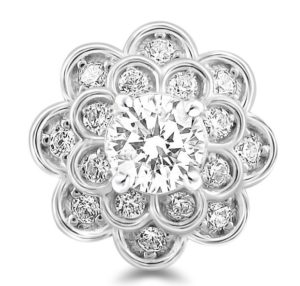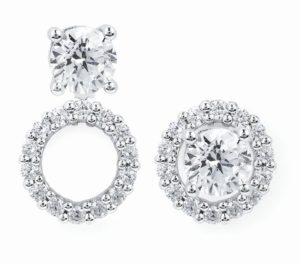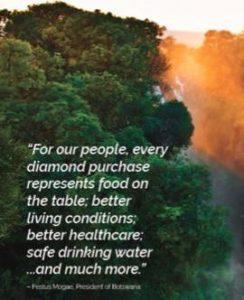Diamond’s Opportunity to Shine
“Life is about memories, not diamonds. But diamonds are the way we store our most precious memories,” tells Martin Rapaport, chairman of Rapaport Group and founder of Rapaport Diamond Report in his annual state of the diamond market report during the JCK Las Vegas Show.
 Rapaport offers a positive outlook for U.S. diamond demand, but only if the trade proactively embraces change and meets the emotional and social demands of a rapidly growing consumer base. The diamond and jewelry industry is coming under extreme pressure from internet technology that is disrupting the supply chain and the way consumers learn about and buy products. It’s cutting out profit centers, and every stage of the supply chain is going direct to consumers.
Rapaport offers a positive outlook for U.S. diamond demand, but only if the trade proactively embraces change and meets the emotional and social demands of a rapidly growing consumer base. The diamond and jewelry industry is coming under extreme pressure from internet technology that is disrupting the supply chain and the way consumers learn about and buy products. It’s cutting out profit centers, and every stage of the supply chain is going direct to consumers.
“Extreme price and availability transparency in the internet age challenges profitability,” Rapaport tells. “We must identify and segment our added value propositions to remain profitable. If we do not change, innovative technology will push us out. Customizable, experiential and extreme customer service is important to consumers, particularly millennials. The key steps to customer acquisition include thought leadership, market segmentation, and engagement marketing. The challenge, opportunity and money is in customer acquisition, sales are a byproduct.”
Embracing new communications technology; being innovative in how you meet, help, and sell to customers; and targeting groups (people, products, and channels) help jewelers identify “value creation opportunities”. “We live in a multi-channel communication world,” says Rapaport. “Jewelers need to use the right channels to communicate the right products to the right people at the right times.”
Communication Competition
Jewelers need to evolve from price and product competition to online communication competition, says Rapaport. Use social media to authentically communicate your identity. Communicate who you are and how you can help people get what they want. Don’t be a product pusher.”
 Social media and experiential marketing is key when communicating to the next generation, concurs Maren Spence, merchandise manager for Ostbye, Minneapolis, Minnesota. “Showing you care, being authentic and interacting with customers are critical and social media offers many channels to communicate.”
Social media and experiential marketing is key when communicating to the next generation, concurs Maren Spence, merchandise manager for Ostbye, Minneapolis, Minnesota. “Showing you care, being authentic and interacting with customers are critical and social media offers many channels to communicate.”
But Spence acknowledges that it can be overwhelming to keep up with and encourages jewelers partner with manufacturers who provide copy, images and videos. “We offer customers a weekly email blast of four images with text that they can easily post or share on Instagram and other platforms.”
Nick Parekh for Laxmi Diamond in New York says the diamond and fine jewelry industry is behind in embracing the internet and e-commerce and he is just starting to see more retailers paying attention to their online presence, noting that retail giant Signet has invested a lot in its website and social media.
 Rapaport underscores that the diamond trade is under pressure to increase oversight and transparency in the supply chain. “Numerous forces from consumers to law enforcement, banks to brands are requesting independently audited source certification to ensure the legitimacy of diamonds.”
Rapaport underscores that the diamond trade is under pressure to increase oversight and transparency in the supply chain. “Numerous forces from consumers to law enforcement, banks to brands are requesting independently audited source certification to ensure the legitimacy of diamonds.”
Responsible members of the diamond trade are upgrading their compliance through implementation of RJC (Responsible Jewellery Council) COP (Code of Practices) certification, De Beers BPP and Signet D-SRSP standards. “The idea is that all of us are responsible for what we buy and sell,” Rapaport says. “Purchasing power requires responsibility to ensure the legitimacy of our products.”
Rebecca Foerster for Leo Schachter Diamonds in New York emphasizes the opportunity the trade has to tell stories about diamonds. “It’s the responsibility of every manufacturer and retailer to tout the attributes that make diamonds so valued. It’s quite a story—from how it was formed in the earth to how it is mined, cut and designed to how diamonds do good along the way.”
She reminds jewelers that there are resources they can use for best practices, information, training, and sales tools like RJC, Diamond Empowerment Fund, and Diamond Producers Association (DPA). “We translate diamond’s story in every brand we have.” She cites a new brand called Kalahari Dream that is part of diamond community initiatives in Botswana, Namibia and South Africa where the stones derive. With the tagline: “Unearth a diamond, uplift a community”, production has funded hospitals, primary and employment education, clean drinking water, and more. In fact, Leo Schachter’s cutting factory in Botswana empowers women in the community, who make up a large part of its workforce.
“We’re less shy talking about these things,” says Foerster. The line, which was launched at Borsheims Fine Jewelry nearly a year ago, has been well received, with an incentive to reach its sales goal to bring in a water tank to a community. “We’ve created a beautiful display, brochures, branded and GIA certificates, look book with 10 humanitarian and nature stories, social media strategy, and retailer locator to drive traffic. A lot depends on us to be more inventive.”
 Jeffrey Cohen, vice-president of sales, KGS Jewels, New York, advocates jewelers carefully curate collections of diamond products to create an experience and provide something meaningful. “Present and merchandise properly. Even if it’s generic goods, create excitement by telling a story.”
Jeffrey Cohen, vice-president of sales, KGS Jewels, New York, advocates jewelers carefully curate collections of diamond products to create an experience and provide something meaningful. “Present and merchandise properly. Even if it’s generic goods, create excitement by telling a story.”
Leave a Reply
You must be logged in to post a comment.